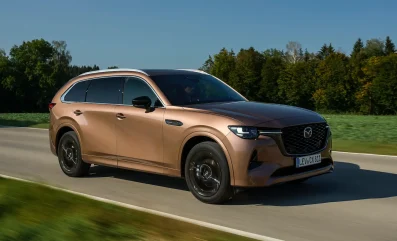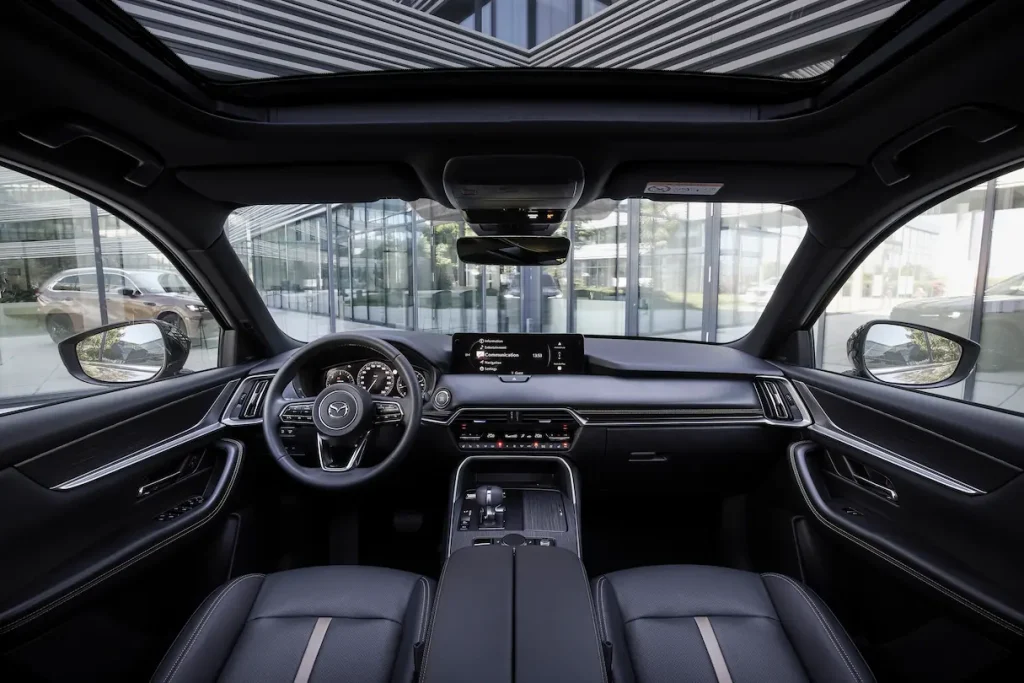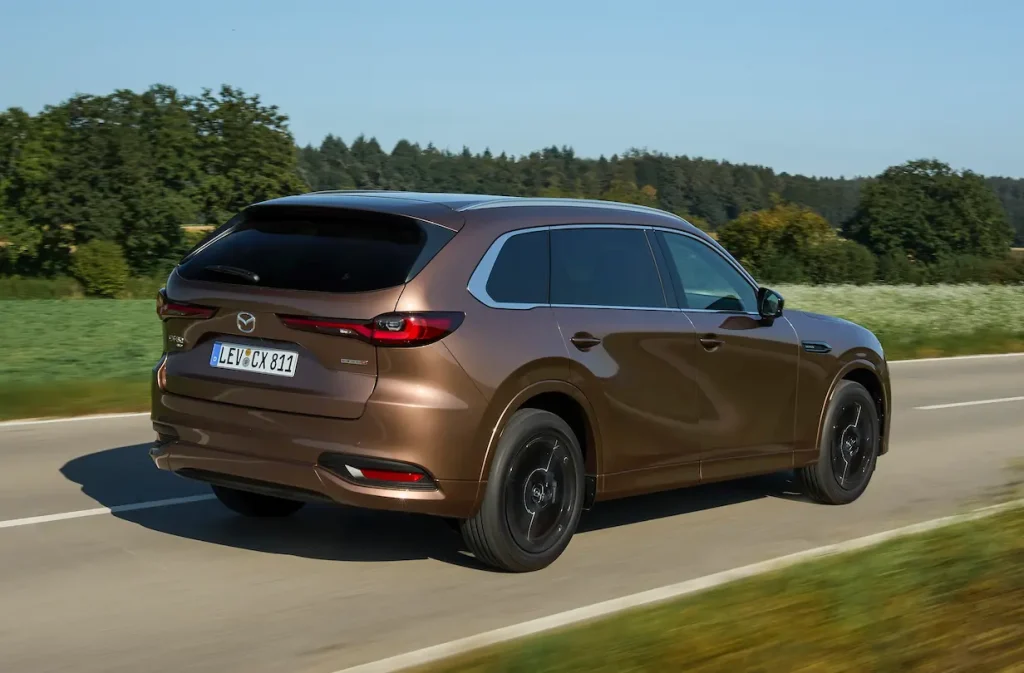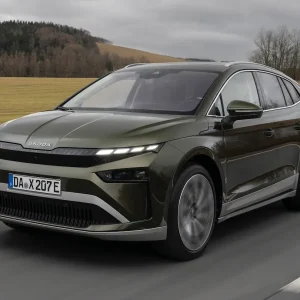
Mazda continues to carve its own niche when it comes to how it powers its cars. Rivals might be plotting their own EV course to 2035, but like Toyota, Mazda still believes there is life in the combustion engine yet and continues to develop and offer petrol and diesel engines, with impressive fuel consumption – although an EV range is incoming.
Remember the CX-60 that was launched in the UK in 2022? On top of having Mazda’s first plug-in hybrid petrol engine, this keen driving SUV was more recently available with the impressively frugal mild-hybrid, 3.3-litre Skyactiv diesel. Well, now it has a bigger, range-topping sibling – the CX-80, with its sights set on Skoda’s impressive new Kodiaq.
Outside, the link between the CX-60 and CX-80 is clear, as they are effectively the same car until the end of the front doors. From there, the most obvious differences are the longer rear doors, and quarters – the result of fitting the extra seats. It is best described as attractive, but maybe a bit ungainly from the rear, where the longer rear doors and quarters are most obvious.
Interior features
The inside, like the outside, is largely the same as in the CX-60. It is still an attractive design, with logically-placed switchgear This is backed up by quality materials and trim – a good sign considering its premium aspirations. Interior highlights include the 12.3in driver display, with its easy-to-read graphics.

Space in the front of this Mazda is adequate and the driving position is good. Move to the second row, and there are two layouts to choose from. We had the separate ‘captain’ seats option for the second row, which can be slid fore and back, but are expected to be less popular with UK buyers. Key rival, the plug-in version of the Skoda Kodiaq, is only available with five-seats! In the CX-80, with all three sets of seats in place, boot space is 258-litres. However, fold them all, and this jumps to 1,971 litres, but the curvy boot doesn’t open as high as you might expect.
Performance and drive
Available with the choice of plug-in hybrid petrol and diesel power, it’s the plug-in that’s expected to get the most fleet interest. The PHEV version combines a 2.5-litre naturally aspirated petrol engine with a 17.9kWh battery and rear motor. The result is 327hp, although it never felt that quick during our drive. Fleet drivers will be more interested in the 37 miles of electric range, 176.5mpg, and the 12% BIK figure. On the road, it’s a smooth operator – unless you need to accelerate! Then, the petrol engine gets noisy and thrashy. The modes don’t appear to change much about the drive, other than in ‘Sport’ where the engine stays on all the time – but feels even more strained, although the throttle response feels snappier.
Both CX-80 versions are four-wheel drive. If you go diesel instead, you get 250hp from a 3.3-litre straight six, features clever pistons, fuel injection technology, and is aided by a 48V mild hybrid system, or M-Hybrid Boost, which also includes a 17hp electric motor to help efficiency when starting off – or at low revs. Highlights are 550Nm of torque, and the lusty soundtrack – although the BiK rating jumps to 34%. This is a lazy but frugal engine, and the most satisfying of the CX-80s to drive.

On the road, the keen, accurate steering marks the CX-80 out – it feels far sportier than the Kodiaq. Mazda has also worked on its ride, with softer springs and the removal of the rear anti-roll bar. The result is a more comfortable, compliant ride, but at the expense of any driving fun. Other less favourable driving characteristics remain from the CX-60. The brakes are hard to modulate at low speeds. Plus, the throttle response can be snatchy – especially when the hybrid battery is empty.
Overall, like the CX-60 before it, the CX-80 is a welcome addition to the SUV sector, with its quality, equipment and practicality. However, we’re keen to try this car on UK roads, as on current evidence, the Skoda remains our favourite.
Positive: Keen steering, quality interior, practicality, old-school diesel engine.
Negative: PHEV engine coarse when worked, average to drive, over-soft ride
Standard equipment: 18in alloy wheels, LED automatic headlights and DRLs, electrically adjustable heated and folding door mirrors, automatic wipers, front and rear parking sensors, reversing camera, smart keyless entry, leather seat trim, heated front seats and steering wheel, frameless auto-dimming rear-view mirror, electronic parking brake, 12.3in driver display, 12.3in central display with sat-nav, wireless Apple Carplay and Android Auto connectivity, cruise control, dual-zone climate control, windscreen-projected colour head-up display, blind spot monitoring with rear cross-traffic alert, driver attention alert, intelligent speed assist, lane keep assist with lane departure warning, autonomous emergency braking with turn-across traffic function, traffic sign recognition.
Engines: Plug-in hybrid: 327hp 2.5; Diesel mild hybrid: 250hp 3.3
Equipment grades: Exclusive-Line, Homura, Homura Plus, Takumi, Takumi Plus
Transmissions: Eight-speed automatic
| Model | Mazda CX-60 E-Skyactiv PHEV Homura Plus |
| P11D | £54,665 |
| Residual value | 41% |
| Depreciation | £32,290 |
| Fuel | tbc |
| Service, maintenance and repair | £3,158 |
| Cost per mile | tbc |
| Fuel consumption | 176.6mpg |
| CO2 (BIK%) | 36g/km (12%) |
| BIK 20/40% a month | £109/£218 |
| Luggage capacity | 258 litres |
| Engine size/power | 2,488cc/190hp petrol engine with 175hp electric motor |
| Score | 8/10 |





